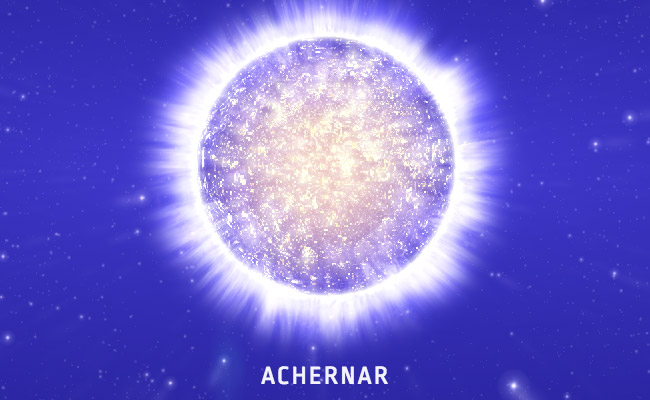Achernar – Star Facts

Due to its extreme temperatures, Achernar is the 9th brightest star in the night sky and is 3,150 times more luminous than the Sun. Before the discovery of Achernar by early voyagers, the star we now call Acamar held the place of brightest star by the early Grecian. However, once Achernar was discovered to be the actual ‘end of the river’, it took its rightful name and place in the constellation of Eridanis.
Constellation Home
Achernar is located in the Southern corner of the constellation Eridanus. It is also known as Alpha Eridani, HR 472 and HD 10144. It is located a mere 139 light-years from Earth; 817 trillion miles or 1,314 trillion kilometers. This star never rises above the horizon if you are North of 33 degrees and never sets below the horizon South of 33 degrees. In other words, you will most likely never see Achernar if you live in the Northern hemisphere.
Observation
Achernar is a very bright star which can only be seen in certain locations around the world. However, where it is present it is visible to the naked eye. The best time to observe this beauty in the Southern hemisphere is in the month of November. In the dark night sky its constellation appears just under Orion. Follow Eridanus to its Southern tip to view Achernar in its full glory.

Star Characteristics and Features
Achernar is considered a main sequence star and shines a hot blueish color. It is six to eight times more massive than the Sun and eight to ten times the diameter of the Sun. In addition, Achernar is also a very fast spinner, completing a rotation every two days. For this reason, Achernar is flattened and its poles are hotter than its equator; estimated temperatures 14,500 to 19,300 degrees Kelvins (approximately 26,000 to 32,000 Fahrenheit or 14,426 to 17,760 degrees Celsius). Plus, due to its fast rotation this star also has a circumstellar disk of gas. Archernar does has a class A-type companion star classified as a Lambda Eridani type variable in its orbit. It is called, Achernar B and is separated by only 12.3 astronomical units from the main star. They orbit each other over a period of 14 to 15 years. Even though the companion star is smaller than Achenar A it is still quite large; about twice that of our Sun
Brightness of the Star
Due to its extreme temperatures, Achernar is the 9th brightest star in the night sky and is 3,150 times more luminous than the Sun. It has an apparent magnitude of 0.46 and is listed as a B3Vpe spectral type star. Plus, it emits approximately 3,000 to 5,000 times more UV rays than the Sun.
History and Mythology
Before the discovery of Achernar by early voyagers, the star we now call Acamar (Theta Eridani) held the place of brightest star by the early Grecian. However, once Achernar was discovered to be the actual “end of the river,” it took its rightful name and place in the constellation of Eridanis. Although, its constellation, Eridanis does have some mythology associated with it, the Achernar star does not.
Achernar is not just another twinkling celestial object, it has some cold hard facts and true significance. So if you have a chance to view this big blue giant, be sure to take a peek at one of the most intriguing views you may ever experience.
